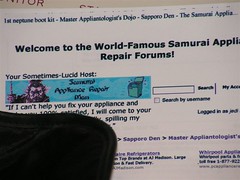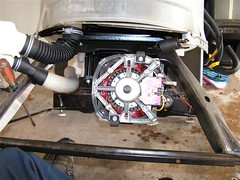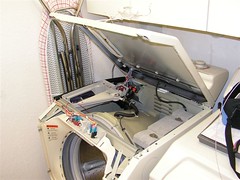1) If the machine has a dryer stacked on top of it or is positioned in such a way that it would be too much bother to move, just leave it where it is. However, if it is possible, it would be easier to do this job if the machine could be leaned. If leaning it back is not possible, then a 6 or 8 inch block of wood will be handy to use to wedge between the front panel and the tub to hold the tub back out of the way.
2) The boot is attached to a lip around the perimeter of the opening in the front panel and is glued on in spots about three inches apart, all the way around. Use a razor blade as shown in illustration #1 to carefully slice the glued spots on the boot away from the front panel.
3) Once the boot is loose from the front panel, push it into the opening of the tub and out of the way as shown in illustration #2. At this point, if the machine is not leaning back, take your block of wood and while pushing back on the tub through the opening, wedge the block between the front panel and the tub about ten inches to the bottom – right of the opening. This will give you more space to work with the boot.
4) Notice that the boot is still attached to the duct that is located just inside the front panel at the upper left corner from the opening. This is where the water, soap, bleach and fabric softener enter the tub. To remove (and later on, reattach) the clamp holding this in place on the end of the duct you will have to make yourself a tool from a three inch piece of 3/8 inch soft copper tubing. In illustration #3 you will see that the end of the tube is flattened somewhat so that it can be slipped over the twisted ends of the clamp as shown in illustration #4. Twist the tube counterclockwise to slip the clamp and set both the tool and the wire clamp aside. Pull the boot free from the duct.
5) Using both hands, grab onto the boot at the top of the opening to the tub and pull downward and toward you with slow steady pressure. As the boot is pulled free from the outer lip of the tub (at the top), the coiled spring that holds the boot from the groove behind the lip around the opening to the front shell will become visible. You can either continue pulling on the boot until it comes off or you can hook the spring (with a piece of coat hanger fashioned into a hook) and pull it off and then pull the boot off separately.
6) Once the boot is off, examine the lip that extends around the entire perimeter of the front opening of the front shell of the tub (the front shell and the rear shell are so named because when bolted together, form the outer tub that surrounds the inner tub). The boot has a lip that will have to be folded into the groove behind the lip on the front shell. To start this, examine the new boot and locate the groove in front of the lip that corresponds to the similar lip and tab on the tub shell. It will make this job a lot easier if you can get some liquid dishwashing soap from the consumer, and sparingly lubricate this groove on the boot to make it easier to slip onto the lip of the shell (see illustration #5). No soap is preferable to too much soap. Have a cloth handy to wipe the soap from your fingers.
7) Once the groove in the boot is lubed with soap, locate the arrow as shown in illustration #6 that is located on the top of the boot (located to the right of the extrusion that slips over the duct). This arrow must point up when the boot is installed.
8) With the boot in one hand and the other hand spreading the lip and groove (on the boot near the arrow), force the lip into the groove behind the lip at the top of the opening on the tub shell (see illustration #7).
9) With one hand holding the boot so it does not slip off, use the other hand to continue spreading the lip and groove of the boot further to the right. In this way, you continue this action 360 degrees around until the boot is mounted onto the front shell ( illustration #8). Your fingers will take a beating while you do this and may become quite tired. Do not give up. Just pop a cold one (without letting go of the boot) and keep at it. Rest one hand at a time if needed. Whatever you do, do not remove both hands until the boot is on (unless you want it to fall off and then you get to start all over with it).
10) Now is the time to put the spring back on. Included in the BOOT KIT is a set of three spacers (an example of which is shown in illustration #9). These spacers are to be used to hold the spring in place in the groove on the outside perimeter of the boot. As it will take both hands to stretch this spring into place, these spacers will prevent the spring from popping out when you let go of it to use both hands to stretch it further around the boot. Begin by pushing the spring down into the groove just forward from where the boot contacts the front shell at about the 12 o’clock position. While holding it in place with one hand, use the other to tightly wedge the spacer above it, between the spring (in its groove) and the weight ring above it as shown in illustration #10.
11) Working your way to the right, push the spring down into the groove. When you have placed the spring about 90 degrees around the opening from the first spacer, the spring will begin to get tight. Push in another spacer at that point (making sure to keep checking the first spacer, if it pops out – the spring will pop out).
12) Continue working your way around (while checking both spacers, you don’t want them to slip out) until you reach 180 degrees from the first spacer. Install the third spacer.
13) The spring will be extremely tight now as shown in illustration # 11. Once you have gone more than half way around, the spring will be easier to roll into the rest of the groove (so long as all three spacers are holding tight). When you have the spring in place, make sure to remove the three spacers before proceeding to step # 14.
14) Replace the boot extrusion back onto the duct and pull it up over the ridge on the duct near the top of the opening. Reinstall the clamp in such a way that the clamp sits between the ridges on the extrusion and above the ridge on the duct. Snap the clamp closed with the copper tubing tool that you used previously.
15) Before attaching the new boot to the front panel, clean the surface of the front panel with alcohol or household cleaner. Also clean the flat surface of the new boot that will be contacting the front panel. This step is needed to remove the mold release material used in the manufacturing process and will allow the adhesive to stick.
16) Remount the boot onto the front panel as shown in illustration #13, making sure that the boot is not wrinkled. If large wrinkles exist, they may pool water in the boot and dribble onto the floor when the door is opened. If this is the case, pull it loose from the front panel and remount it slightly more clockwise or counter clockwise as needed.
17) Using the adhesive supplied in the kit, sparingly apply dots of glue under the edge of the boot as shown in illustration #14. Spot glue at the 12 o’clock, 1, 2, 3, 4, 5, 6, 7, 8 and 9 o’clock positions around the opening. Caution: you will need to wait a couple of hours before using the washer to allow the adhesive enough time to dry.
To learn more about your washing machine, or to order parts, click here.
 Once upon a time, in a place that was called the "land of the free," there was a big ol’ company called Dupont. Now, Dupont made a thang that we old timers held near and dear to our hearts and that was R-12, a refrigerant used in just about every type of refrigerator ever made, including beer coolers. But Dupont had a problem: their patent on R-12 was about to expire and everyone else and their momma was gonna start making it, too. Well, it don’t take a rocket scientist, like yours truly, to figger out that once this happened, the price of R-12 was gonna take a nose dive.
Once upon a time, in a place that was called the "land of the free," there was a big ol’ company called Dupont. Now, Dupont made a thang that we old timers held near and dear to our hearts and that was R-12, a refrigerant used in just about every type of refrigerator ever made, including beer coolers. But Dupont had a problem: their patent on R-12 was about to expire and everyone else and their momma was gonna start making it, too. Well, it don’t take a rocket scientist, like yours truly, to figger out that once this happened, the price of R-12 was gonna take a nose dive.  Anyway, Dupont goes and presents all these high falootin’ studies to one of the fourth branches of the gubmint, the EPA. The EPA said, "Hmmm, we can’t be eatin’ up all them little orzos like that there. Gubmint has to do something about that!" So they came out with a big ol’ riot act of new regamalations where they said everyone what works on beer coolers has to have a new-fangled recovery unit to catch all them bad molecules.
Anyway, Dupont goes and presents all these high falootin’ studies to one of the fourth branches of the gubmint, the EPA. The EPA said, "Hmmm, we can’t be eatin’ up all them little orzos like that there. Gubmint has to do something about that!" So they came out with a big ol’ riot act of new regamalations where they said everyone what works on beer coolers has to have a new-fangled recovery unit to catch all them bad molecules. 
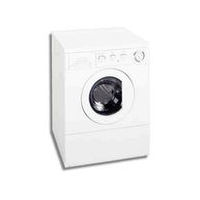
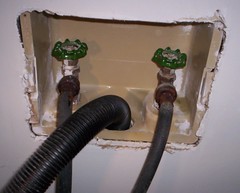
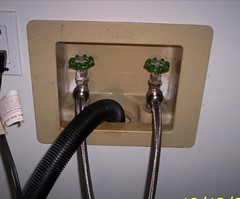
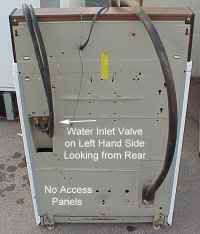 Yep, sounds like your water inlet valve can’t quite pinch it off anymore. The valve is mounted to the washer’s rear bulkhead (that’s Navy talk for “wall” or “panel” — don’t let it throw you), as seen here to the right.
Yep, sounds like your water inlet valve can’t quite pinch it off anymore. The valve is mounted to the washer’s rear bulkhead (that’s Navy talk for “wall” or “panel” — don’t let it throw you), as seen here to the right.



